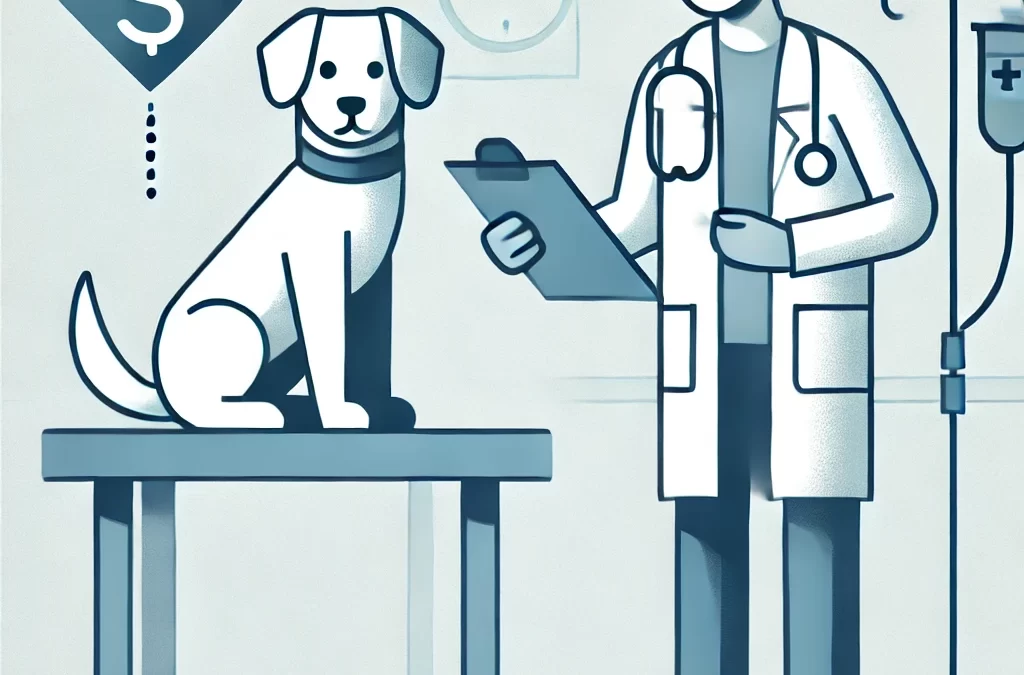
par TCMVET | 25 novembre 2024 | Cancer et tumeurs du chien
L'ostéosarcome, un cancer des os très agressif, suscite souvent la peur chez les propriétaires de chiens. Les traitements conventionnels comme l'amputation et la chimiothérapie, bien que courants, peuvent être éprouvants financièrement et émotionnellement. Cependant, les thérapies naturelles gagnent du terrain en raison de leur potentiel à améliorer la qualité de vie, à soulager les symptômes et à soutenir les processus de guérison du corps. Ci-dessous, nous examinons une variété de traitements naturels innovants adaptés à l'ostéosarcome canin.
Comprendre l'ostéosarcome chez le chien
L'ostéosarcome touche généralement les races de grande taille et géantes, ciblant les membres. Il se caractérise par une croissance tumorale rapide et un risque élevé de métastases aux poumons. Une détection précoce et une approche thérapeutique multidimensionnelle peuvent améliorer considérablement la qualité de vie d'un chien.
Traitements naturels pour accompagner votre chien dans son voyage
1. Remèdes à base de plantes pour la gestion de la douleur
La gestion naturelle de la douleur peut réduire la dépendance aux produits pharmaceutiques, qui ont souvent des effets secondaires. Pensez à ces plantes :
- Boswellia Serrata:Connue pour ses propriétés anti-inflammatoires, cette résine réduit les gonflements et améliore la mobilité.
- Curcuma (curcumine):Puissant anti-inflammatoire et antioxydant, le curcuma peut soulager l’inconfort articulaire et a été étudié pour ses effets anticancéreux.
- Yunnan Baiyao:Une formule à base de plantes chinoises réputée pour favoriser la circulation sanguine et soulager la douleur, en particulier dans les cas de blessures osseuses ou de cancer.
2. Stratégies alimentaires pour renforcer l’immunité
L'alimentation joue un rôle essentiel dans le soutien du système immunitaire d'un chien pendant le traitement contre le cancer. Focus sur :
- Régimes riches en protéines:Pour maintenir la masse musculaire et les niveaux d’énergie.
- Acides gras oméga-3:Présents dans l’huile de poisson, ils aident à réduire l’inflammation et peuvent ralentir la croissance tumorale.
- Repas à faible teneur en glucides et à haute teneur en matières grasses:Les cellules cancéreuses se nourrissent de sucre, c’est pourquoi les régimes de type cétogène peuvent limiter la progression tumorale.
3. Le cannabidiol (CBD) pour le traitement du cancer
L'huile de CBD dérivée du chanvre est reconnue pour ses propriétés anti-inflammatoires et anti-tumorales. Elle aide à :
- Réduisez la douleur et l’anxiété.
- Améliore l’appétit et les niveaux d’énergie.
- Ils peuvent potentiellement inhiber la croissance des cellules cancéreuses, comme le montrent de nouvelles études.
Lorsque vous choisissez de l’huile de CBD, assurez-vous qu’elle est à spectre complet, biologique et sans THC.
4. Acupuncture and Traditional Chinese Medicine (TCM)
Les traitements de la MTC comme l’acupuncture peuvent compléter d’autres thérapies en :
- Soulage la douleur et améliore la circulation sanguine.
- Améliorer la fonction immunitaire.
- Rétablir l'équilibre de l'énergie du corps (Qi).
Des formules à base de plantes telles que Baituxiao peut cibler spécifiquement la croissance tumorale et améliorer le bien-être général. Consultez toujours un vétérinaire expérimenté en MTC pour personnaliser les traitements pour votre chien.
5. Physiothérapie et exercices doux
Après une intervention chirurgicale ou dans le cadre de soins palliatifs, la physiothérapie aide à :
- Maintenir la mobilité et prévenir l'atrophie musculaire.
- Stimule l'humeur et l'engagement mental. Des activités comme la natation ou la marche contrôlée peuvent être particulièrement efficaces pour les chiens ayant subi une amputation d'un membre.
6. Approches homéopathiques
Certains propriétaires d’animaux de compagnie explorent les remèdes homéopathiques, tels que :
- Symphytum:Connu sous le nom de « tricot osseux », ce remède peut favoriser la guérison osseuse.
- Lave d'Hecla:Utilisé pour les affections osseuses, y compris les tumeurs et l'ostéosarcome.
Consultez un vétérinaire homéopathe pour obtenir des conseils et un dosage appropriés.
Étude de cas : Un voyage naturel
Prenons l'histoire de Bella, un dogue allemand de 9 ans à qui on a diagnostiqué un ostéosarcome. Après son amputation, son propriétaire a complété le traitement conventionnel par un régime riche en protéines et faible en glucides, de l'huile de CBD et de l'extrait de Boswellia. Des séances d'acupuncture régulières ont amélioré la mobilité et l'humeur de Bella. L'approche holistique a non seulement prolongé sa vie, mais lui a également permis de vivre dans le confort et la dignité.
Conseils pour les propriétaires de chiens qui explorent les traitements naturels
- Travailler avec un vétérinaire holistique:La collaboration garantit que les thérapies sont sûres et efficaces.
- Surveiller de près les progrès:Des examens réguliers et des examens d’imagerie permettent d’évaluer l’efficacité des traitements.
- Restez ouvert d'esprit:Combiner les traitements naturels et conventionnels donne souvent les meilleurs résultats.
L’importance du soutien émotionnel
Prendre soin d'un chien atteint d'un cancer peut être émotionnellement épuisant. Construire un réseau de soutien composé d'amis, de membres de la famille et de vétérinaires holistiques vous permet de ne pas être seul dans cette épreuve.
Conclusion
Les traitements naturels contre l'ostéosarcome chez le chien visent à améliorer la qualité de vie, à soulager la douleur et à soutenir le système immunitaire. En combinant des thérapies naturelles fondées sur des preuves avec des traitements traditionnels, vous pouvez créer un plan de soins qui donne la priorité au confort et au bien-être de votre chien. N'oubliez pas que chaque chien est unique et qu'une approche personnalisée est la clé du succès.
Votre compagnon canin mérite une chance de se battre, bien entendu.

par TCMVET | 24 novembre 2024 | Cancer et tumeurs du chien
Lorsqu'un animal de compagnie bien-aimé reçoit un diagnostic de cancer, le coût émotionnel pour ses compagnons humains est immense. Mais à côté du chagrin vient une autre réalité décourageante : le coût du traitement. Les traitements contre le cancer des animaux de compagnie peuvent sauver des vies, mais ils sont souvent très coûteux. Alors, quel est le coût réel de donner une chance à votre ami à quatre pattes et comment mesurons-nous la valeur de sa vie en dollars ?
Décomposer le coût moyen
Le coût du traitement du cancer des animaux de compagnie varie considérablement en fonction de facteurs tels que le type de cancer, le stade du diagnostic, les options de traitement et la localisation. Voici une répartition générale :
- Diagnostic:
- Les radiographies, les échographies, les biopsies et les analyses de sang peuvent coûter entre $500 et $1,500. L'imagerie avancée comme les tomodensitogrammes ou les IRM peut ajouter un autre $1 000 à $2 500.
- Chirurgie:
- L’ablation chirurgicale d’une tumeur varie souvent de $1 000 à $5 000, selon la complexité et l'emplacement.
- Chimiothérapie:
- Les protocoles de chimiothérapie peuvent coûter entre $3,000 et $10,000, en fonction du nombre de séances et des médicaments utilisés.
- Radiothérapie:
- Ce traitement avancé peut aller de $5 000 à $15 000, ce qui en fait l’une des options les plus chères.
- Soins palliatifs:
- Si les traitements curatifs ne sont pas viables, les soins palliatifs pour gérer les symptômes peuvent encore coûter cher. $500 à $2 000.
Au total, le coût moyen du traitement du cancer des animaux de compagnie peut se situer entre $5 000 et $20 000— et parfois même plus. Ces chiffres sont inquiétants, surtout lorsqu’on les compare au budget d’un ménage.
Le coût émotionnel et le coût financier
Pour de nombreux propriétaires d'animaux de compagnie, la décision de suivre un traitement contre le cancer n'est pas seulement financière, mais aussi profondément émotionnelle. Les animaux font partie de la famille et l'idée de ne pas faire tout ce qui est possible pour les sauver semble insupportable. Pourtant, la réalité de l'oncologie vétérinaire est que le succès n'est pas garanti et même des traitements agressifs ne peuvent prolonger la vie d'un animal que de quelques mois ou de quelques années.
- Considérations émotionnelles:
La valeur du temps gagné grâce au traitement, qu’il s’agisse de semaines, de mois ou d’années, ne peut pas être facilement quantifiée. De nombreux propriétaires d’animaux de compagnie déclarent que même quelques mois supplémentaires de temps de qualité avec leur animal en valaient la peine.
- Pression financière:
Cependant, le fardeau financier peut engendrer de la culpabilité et du stress, surtout lorsque les coûts du traitement interfèrent avec les besoins du ménage. C'est une situation peu enviable : comment dire non quand l'amour est en jeu ?
Existe-t-il des moyens de réduire les coûts ?
Les propriétaires d’animaux confrontés à un diagnostic de cancer doivent savoir qu’il existe des moyens de gérer et de réduire les coûts de traitement :
- Assurance pour animaux de compagnie:
Souscrite suffisamment tôt, une assurance pour animaux de compagnie peut couvrir une partie importante des coûts de traitement du cancer. Toutefois, les maladies préexistantes sont généralement exclues.
- Organisations à but non lucratif:
Plusieurs organismes offrent une aide financière pour les soins médicaux des animaux de compagnie, notamment pour le traitement du cancer.
- Options holistiques et palliatives:
Pour les animaux de compagnie dont le pronostic est mauvais, les traitements holistiques tels que l’huile de CBD, l’acupuncture ou les suppléments naturels peuvent offrir un moyen plus abordable d’améliorer la qualité de vie.
- Essais cliniques:
Certaines institutions vétérinaires mènent des essais cliniques pour de nouveaux traitements contre le cancer, couvrant souvent une partie des coûts.
- Discutez des options avec votre vétérinaire:
De nombreux vétérinaires sont disposés à collaborer avec les propriétaires d'animaux pour élaborer un plan de traitement réaliste et abordable. Certaines cliniques proposent également des plans de paiement.
Est-ce que ça vaut le coup ?
La question de savoir si le coût du traitement contre le cancer des animaux de compagnie en vaut la peine est très personnelle. Pour certains, la réponse est un oui retentissant, car aucun prix n’est trop élevé pour l’amour. Pour d’autres, la décision de renoncer au traitement n’est pas un signe d’échec, mais un acte de compassion, privilégiant le confort et la dignité de l’animal plutôt que la prolongation de sa vie à tout prix.
Redéfinir la valeur des soins contre le cancer chez les animaux de compagnie
En fin de compte, le coût moyen du traitement du cancer des animaux de compagnie n’est pas seulement une statistique financière, mais aussi le reflet des efforts que nous sommes prêts à faire pour nos compagnons à quatre pattes. Ce voyage est autant une question d’espoir, d’amour et de résilience qu’une question d’argent. Que vous choisissiez de suivre un traitement ou d’opter pour des soins palliatifs, la décision doit respecter le lien que vous partagez avec votre animal et sa qualité de vie.
À mesure que le domaine de l'oncologie vétérinaire progresse, peut-être qu'un jour nous n'aurons plus à mesurer notre amour en dollars. En attendant, nous faisons de notre mieux, avec notre cœur et notre portefeuille, pour offrir à nos animaux de compagnie la vie qu'ils méritent.

par TCMVET | 24 novembre 2024 | Cancer et tumeurs du chien
L'utilisation de remèdes naturels pour gérer le cancer canin a suscité une attention considérable ces dernières années, l'absinthe devenant un concurrent intrigant. Connu scientifiquement sous le nom Artemisia absinthiumL'absinthe est une plante médicinale traditionnelle qui a une longue histoire, mais ses bienfaits potentiels dans la lutte contre le cancer, en particulier chez les chiens, n'ont suscité l'intérêt des chercheurs et des propriétaires d'animaux que récemment. Cette plante ancienne pourrait-elle être prometteuse dans la lutte contre le cancer canin ?
Qu'est-ce que l'absinthe ?
L'absinthe est une plante herbacée vivace réputée pour son goût amer et ses propriétés médicinales. Traditionnellement utilisée pour traiter les problèmes digestifs et les infections parasitaires, l'absinthe est également reconnue pour ses propriétés anti-inflammatoires, antimicrobiennes et même anticancéreuses potentielles. Son principal composé actif, l'artémisinine, a été largement étudié pour son efficacité contre certains types de cellules cancéreuses chez l'homme.
La science derrière l’absinthe et le cancer
Les recherches suggèrent que l’artémisinine pourrait agir en ciblant les cellules cancéreuses riches en fer, un minéral que les cellules cancéreuses accumulent souvent pour favoriser leur croissance rapide. L’artémisinine interagit avec ce fer, produisant des radicaux libres qui peuvent détruire les cellules cancéreuses tout en laissant les cellules saines relativement indemnes. Si la plupart des études se sont concentrées sur les applications humaines, les principes ont suscité un intérêt pour l’oncologie vétérinaire.
L'absinthe et le cancer canin : le lien potentiel
Les chiens diagnostiqués d'un cancer, comme l'ostéosarcome, le lymphome ou les tumeurs des mastocytes, sont souvent confrontés à des traitements coûteux et invasifs comme la chirurgie, la chimiothérapie ou la radiothérapie. De nombreux propriétaires d'animaux se tournent vers des thérapies complémentaires pour améliorer la qualité de vie de leurs chiens, et l'absinthe est de plus en plus explorée à cette fin. Des preuves anecdotiques provenant de vétérinaires holistiques et de propriétaires d'animaux suggèrent que l'absinthe pourrait aider à réduire la croissance tumorale, à soulager l'inflammation et à stimuler la vitalité globale.
Comment l'absinthe pourrait aider les chiens atteints de cancer
- Propriétés anticancéreuses:L’artémisinine contenue dans l’absinthe peut cibler et tuer les cellules cancéreuses, ralentissant potentiellement la progression de la maladie.
- Effets anti-inflammatoires:Les propriétés anti-inflammatoires de l’absinthe pourraient réduire l’inconfort et améliorer la mobilité chez les chiens atteints de tumeurs ou de métastases.
- Soutien immunitaire:On pense que l’absinthe soutient le système immunitaire, ce qui est essentiel pour les chiens qui luttent contre le cancer.
Précautions et considérations
Malgré son potentiel, l'absinthe n'est pas sans risques. De fortes doses peuvent être toxiques et provoquer des effets secondaires tels que des vomissements, de la diarrhée ou des problèmes neurologiques. De plus, tous les chiens ne sont pas des candidats adaptés aux thérapies à base d'absinthe. Il est essentiel de consulter un vétérinaire holistique ou intégratif avant d'introduire l'absinthe dans le régime alimentaire de votre chien.
Des attentes réalistes : un outil complémentaire
Il est important de noter que l'absinthe n'est pas un remède contre le cancer, mais une thérapie complémentaire potentielle. Ses bienfaits peuvent varier en fonction du type et du stade du cancer, ainsi que de l'état de santé général du chien. L'association de l'absinthe avec des traitements conventionnels ou d'autres remèdes naturels, tels que l'huile de CBD ou les champignons médicinaux, peut améliorer son efficacité tout en offrant une approche multidimensionnelle du traitement du cancer.
L'avenir de la recherche sur l'absinthe en médecine vétérinaire
L’absence d’essais cliniques approfondis sur l’absinthe pour le traitement du cancer canin souligne la nécessité de poursuivre les recherches. Cependant, les premières découvertes et les succès anecdotiques laissent entrevoir son potentiel dans le cadre d’une stratégie plus large de traitement naturel du cancer. Avec une validation scientifique plus poussée, l’absinthe pourrait devenir un élément de base des soins vétérinaires holistiques.
Conclusion
Pour les propriétaires d'animaux de compagnie à la recherche d'options alternatives pour améliorer la qualité de vie de leur chien, l'absinthe représente une possibilité fascinante. Ses propriétés anticancéreuses et de soutien potentielles en font un candidat intéressant à prendre en considération dans la gestion du cancer canin. Cependant, comme pour tout traitement, la prudence et les conseils d'un professionnel sont essentiels. Si vous envisagez d'utiliser l'absinthe pour votre chien, n'oubliez pas : le chemin vers la santé consiste souvent à combiner le meilleur des approches traditionnelles et modernes.
L'absinthe et le cancer du chien : une plante ancienne pour un défi moderne. Serait-ce la solution naturelle dont votre compagnon à quatre pattes a besoin ? Seul le temps et la recherche nous le diront.

par TCMVET | 23 novembre 2024 | Cancer et tumeurs du chien
Les tumeurs à mastocytes (TMC) sont l'un des types de cancer les plus courants chez les chiens, se présentant souvent sous forme de bosses sur la peau. Si certains chiens survivent grâce à un traitement rapide, d'autres succombent à cette maladie. Le processus par lequel les tumeurs à mastocytes conduisent à la mort peut être à la fois complexe et progressif, impliquant une cascade de perturbations biologiques qui affectent l'ensemble du corps du chien. Cet article se penche sur le parcours peu exploré de la façon dont les tumeurs à mastocytes peuvent conduire à des résultats mortels.
Le champ de bataille biologique : comprendre les tumeurs des mastocytes
Les mastocytes font partie du système immunitaire et sont responsables de la libération d'histamines et d'autres substances chimiques pour combattre les allergènes et les infections. Cependant, lorsque ces cellules deviennent cancéreuses, elles provoquent des ravages dans le corps.
Les tumeurs des mastocytes deviennent souvent dangereuses non pas à cause de la tumeur primaire elle-même, mais à cause de leurs effets systémiques. Ces effets peuvent déclencher des complications potentiellement mortelles qui pourraient surprendre de nombreux propriétaires de chiens.
Les tueurs silencieux : les mécanismes à l’origine des décès
1. Surcharge d'histamine : la tempête intérieure
L’un des effets les plus insidieux des tumeurs à mastocytes est la libération excessive d’histamines et d’autres médiateurs chimiques. Cela peut entraîner :
- Ulcères gastriques : l'histamine stimule la production d'acide dans l'estomac, ce qui peut provoquer des ulcères. Ces ulcères peuvent saigner, entraînant une anémie sévère ou des hémorragies potentiellement mortelles.
- Choc : une libération soudaine d’histamine peut entraîner une inflammation systémique et une chute dangereuse de la pression artérielle, pouvant conduire à un choc anaphylactique.
2. Défaillance d'organe : un effet domino
Lorsque les tumeurs mastocytaires métastasent, elles envahissent des organes vitaux comme le foie, la rate et la moelle osseuse. Cela peut entraîner :
- Dysfonctionnement hépatique : l’incapacité du foie à traiter les toxines peut entraîner une jaunisse et un empoisonnement systémique.
- Suppression de la moelle osseuse : si les mastocytes infiltrent la moelle osseuse, la production de globules rouges et blancs est altérée, provoquant une anémie et un affaiblissement du système immunitaire.
3. Cachexie : le syndrome de dépérissement du cancer
La cachexie, ou dépérissement lié au cancer, est une cause fréquente de décès chez les chiens atteints de tumeurs avancées des mastocytes. La tumeur altère le métabolisme du chien, provoquant :
- Perte musculaire : Malgré l’alimentation, les chiens perdent de la masse musculaire et de la force.
- Fatigue : Cette condition débilitante peut rendre même des activités simples insupportables.
4. Croissance tumorale incontrôlée : destruction localisée
Dans certains cas, la tumeur elle-même se développe de manière agressive, infiltrant les tissus environnants. Cela peut provoquer :
- Plaies ouvertes : les tumeurs ulcérées peuvent s’infecter, entraînant une septicémie.
- Problèmes de douleur et de mobilité : les tumeurs situées à proximité des articulations ou des structures critiques peuvent provoquer une douleur atroce et limiter les mouvements.
Au-delà de la biologie : changements émotionnels et comportementaux
Les chiens souffrant de tumeurs à mastocytes peuvent présenter des changements de comportement dus à la douleur, à l'inconfort ou à une maladie systémique. Des signes tels que l'agitation, l'agressivité ou le repli sur soi sont souvent négligés mais indiquent la gravité de leur souffrance.
Briser le silence : l’importance d’une intervention précoce
Bien que les tumeurs des mastocytes puissent être mortelles, leur progression n'est pas toujours inévitable. Une détection et un traitement précoces peuvent modifier considérablement l'issue de la maladie. Voici quelques mesures proactives :
- Visites fréquentes chez le vétérinaire : des contrôles réguliers augmentent les chances de détecter les tumeurs à leurs premiers stades.
- Biopsie de toutes les tumeurs : même les tumeurs d’apparence bénigne peuvent être des tumeurs à mastocytes.
- Thérapies combinées : la chirurgie, la radiothérapie et la chimiothérapie sont des approches courantes, mais de nouvelles méthodes comme l’immunothérapie émergent.
Frontières émergentes : soins holistiques pour les MCT
Au-delà des traitements conventionnels, l’intégration d’approches holistiques peut améliorer la qualité de vie d’un chien :
- Ajustements alimentaires : les régimes anti-inflammatoires contenant des acides gras oméga-3 peuvent favoriser la santé globale.
- Compléments à base de plantes : des ingrédients comme le curcuma et le boswellia peuvent aider à réduire l’inflammation.
- Réduction du stress : le stress chronique peut exacerber les symptômes du cancer ; des environnements apaisants et des exercices doux peuvent faire une différence.
Quand est-il temps de dire au revoir ?
La décision d'euthanasier un chien atteint de tumeurs à mastocytes est l'un des choix les plus difficiles qu'un propriétaire d'animal puisse faire. Des outils comme l'échelle de qualité de vie (QoL) peuvent guider cette décision, en se concentrant sur le niveau de douleur, l'appétit et la capacité du chien à profiter des activités quotidiennes.
Conclusion : comprendre pour responsabiliser
Les tumeurs des mastocytes sont bien plus que de simples tumeurs : ce sont des menaces systémiques qui peuvent submerger silencieusement et progressivement le corps d'un chien. En comprenant les mécanismes à l'origine de leur mortalité, les propriétaires d'animaux et les vétérinaires peuvent prendre des décisions éclairées pour atténuer la souffrance et améliorer les résultats. Forts de nos connaissances, nous pouvons nous assurer que chaque moment passé avec nos animaux de compagnie bien-aimés soit aussi indolore et épanouissant que possible.

par TCMVET | 23 novembre 2024 | Cancer et tumeurs du chien
Lorsque nos amis à quatre pattes sont confrontés à un diagnostic de cancer, la gestion de leur douleur devient l’une des préoccupations les plus urgentes. La douleur affecte non seulement leur qualité de vie, mais aussi leur volonté de manger, de jouer et d’interagir. Les méthodes traditionnelles de soulagement de la douleur, comme les médicaments, s’accompagnent souvent d’effets secondaires qui peuvent laisser les propriétaires d’animaux de compagnie dans une situation conflictuelle. Mais que se passerait-il si nous regardions au-delà des méthodes conventionnelles et explorions des approches holistiques innovantes de la gestion de la douleur ?
Comprendre la douleur chez les chiens atteints de cancer
La douleur chez les chiens atteints de cancer est souvent multiforme. Les tumeurs peuvent appuyer sur les nerfs, envahir les tissus ou provoquer une inflammation, entraînant un inconfort aigu ou chronique. Comprendre la nature de cette douleur est essentiel pour choisir la bonne méthode de soulagement.
Les options traditionnelles comme les AINS ou les opioïdes ont leur place, mais elles peuvent comporter des risques comme des troubles gastro-intestinaux, des problèmes hépatiques ou une dépendance. Il est temps de sortir des sentiers battus et de proposer aux propriétaires d'animaux de compagnie des alternatives qui non seulement soulagent la douleur, mais favorisent également la santé globale.
Approches holistiques pour soulager la douleur
1. Acupuncture et acupression
Issue de la médecine chinoise ancienne, l'acupuncture est de plus en plus utilisée par les vétérinaires du monde entier. En stimulant des points spécifiques du corps, l'acupuncture aide à libérer des endorphines, les analgésiques naturels du corps, et améliore la circulation sanguine dans les zones affectées.
- Pourquoi c'est efficace : Les recherches montrent que l’acupuncture peut réduire la douleur et l’inflammation, ce qui en fait une option viable pour les chiens souffrant d’inconfort lié au cancer.
2. Analgésiques à base de plantes
Certains remèdes à base de plantes se sont révélés prometteurs pour réduire l'inflammation et la douleur. Des ingrédients comme Chuanxiong (Livèche du Sichuan), le curcuma et l’encens ont des propriétés anti-inflammatoires naturelles.
- Comment les utiliser : Ils peuvent être incorporés sous forme de suppléments ou de thés (sous contrôle vétérinaire) pour réduire la dépendance aux produits pharmaceutiques traditionnels.
3. Huile de chanvre à spectre complet
Le CBD, dérivé du chanvre, est devenu un produit très apprécié des propriétaires d’animaux de compagnie pour sa double capacité à gérer la douleur et l’anxiété. Les huiles à spectre complet contiennent des cannabinoïdes et des terpènes supplémentaires qui agissent en synergie, offrant encore plus de soulagement.
- Ce qui le distingue : Le CBD interagit avec le système endocannabinoïde du corps, traitant l'inflammation et modulant la douleur sans les effets psychoactifs du THC.
4. Thérapie au laser froid
La thérapie au laser froid est un traitement non invasif qui utilise la lumière pour stimuler la régénération cellulaire et réduire l'inflammation. Cette technique est indolore et peut améliorer considérablement la mobilité et le confort.
- Idéal pour : Chiens qui ont des douleurs articulaires ou des tumeurs affectant leurs membres ou leur dos.
5. L'alimentation comme traitement de la douleur
Un régime alimentaire riche en nutriments et anti-inflammatoire peut changer la donne pour les chiens atteints de cancer. Les aliments riches en acides gras oméga-3 (présents dans l’huile de poisson) et en antioxydants peuvent aider à réduire l’inflammation et la douleur systémiques.
- Recette à essayer : Un mélange de viandes maigres cuites, de légumes en purée comme des carottes et du brocoli, et une pincée de curcuma ou de gingembre peut être à la fois nutritif et thérapeutique.
La composante émotionnelle de la gestion de la douleur
La douleur n'est pas seulement physique, elle a également des conséquences émotionnelles. Les chiens ont tendance à se replier sur eux-mêmes ou à devenir irritables lorsqu'ils souffrent. Leur offrir un environnement sans stress, beaucoup d'affection et une stimulation mentale peut faire une énorme différence.
Essayez ceci : Incorporez la massothérapie à la routine de votre chien. Des caresses et des pressions douces peuvent aider à détendre les muscles tendus et à améliorer la circulation, ce qui permet également de renforcer les liens.
Un aperçu du futur : la médecine régénérative
Des avancées passionnantes dans le domaine de la médecine régénérative, comme la thérapie par cellules souches, ouvrent la voie à des traitements innovants contre la douleur cancéreuse chez les chiens. Les cellules souches peuvent réparer les tissus endommagés et réduire l'inflammation, offrant ainsi de l'espoir pour des maladies jusqu'alors considérées comme incurables.
Créer un plan complet de gestion de la douleur
Soulager la douleur cancéreuse d'un chien ne consiste pas à choisir une méthode, mais à élaborer un plan personnalisé. Travaillez en étroite collaboration avec votre vétérinaire pour combiner le meilleur des thérapies traditionnelles et alternatives.
Exemple de plan :
- Matin : Huile de CBD au petit déjeuner
- Après-midi : Séance d'acupuncture ou thérapie au laser froid
- Soir : Complément à base de plantes avec un repas riche en oméga
Quand dire au revoir
La gestion de la douleur ne concerne pas uniquement le chien, mais aussi le propriétaire de l'animal. Savoir quand lâcher prise est l'une des décisions les plus difficiles, mais c'est parfois le choix le plus affectueux. Surveillez la qualité de vie de votre chien à l'aide d'outils tels que Échelle HHHHHMM (Blessure, Faim, Hydratation, Hygiène, Bonheur, Mobilité et Plus de bons jours que de mauvais) peuvent aider à guider cette décision.
Conclusion : le soulagement de la douleur est un voyage et non une destination
La gestion de la douleur cancéreuse chez le chien nécessite de la créativité, de la compassion et une volonté d'explorer des options non conventionnelles. De l'acupuncture aux ajustements alimentaires, chaque petit pas que vous faites pour soulager la douleur peut améliorer la qualité de vie de votre chien. En tant que propriétaires d'animaux de compagnie, notre plus beau cadeau à nos chiens est de veiller à ce que leur dernier chapitre soit rempli d'autant de confort et d'amour que possible.





